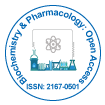
Biochemistry & Pharmacology: Open Access
Open Access
ISSN: 2167-0501
+44-77-2385-9429

ISSN: 2167-0501
+44-77-2385-9429
Perspective Article - (2024)Volume 13, Issue 4
Anaerobic glycolysis often referred to as lactic acid fermentation is a crucial metabolic process that allows cells to produce energy in the absence of sufficient oxygen. This pathway is vital for tissues that experience rapid energy demands such as muscles during intense exercise or in certain pathogens and cancer cells that thrive in low-oxygen environments. While less efficient than aerobic respiration anaerobic glycolysis ensures that cells can continue to generate ATP the energy currency of the body even when oxygen is scarce.
The basics of anaerobic glycolysis
Glycolysis is a sequence of enzymatic reactions that break down glucose into pyruvate generating energy in the form of ATP and NADH. Under normal oxygen-rich conditions, pyruvate enters the mitochondria and is further processed via aerobic pathways like the citric acid cycle. However, in the absence of oxygen cells cannot perform oxidative phosphorylation. Instead pyruvate is converted into lactate (or lactic acid) which regenerates NAD+ from NADH allowing glycolysis to continue producing ATP.
This conversion of pyruvate to lactate is catalysed by the enzyme Lactate Dehydrogenase (LDH) and it is important because it maintains the NAD+/NADH ratio which is need for glycolytic ATP production. Despite the lower energy yield anaerobic glycolysis provides a rapid response to energy needs making it need for short bursts of intense activity.
Energy production and efficiency
The primary purpose of anaerobic glycolysis is to produce ATP. In the complete process of glycolysis one molecule of glucose is converted into two molecules of pyruvate generating a net gain of two ATP molecules. This is in contrast to aerobic respiration where one molecule of glucose yields approximately 36 ATP molecules through processes like the citric acid cycle and oxidative phosphorylation.
While anaerobic glycolysis is significantly less efficient in terms of ATP production its speed compensates for this inefficiency. This rapid production of ATP is especially important during activities such as sprinting weightlifting or when oxygen supply to tissues is insufficient like during ischemia or intense exercise. In muscle cells for example, anaerobic glycolysis is the primary source of energy during short intense activities.
The role in exercise and muscle function
During high-intensity exercise oxygen consumption cannot meet the energy demands of the muscles leading to an increase in anaerobic glycolysis. This phenomenon is particularly evident in activities that require short bursts of energy such as sprinting heavy lifting or intense interval training.
In muscle cells the accumulation of lactate can lead to a drop in pH contributing to the sensation of muscle fatigue. However, this does not mean that lactate directly causes muscle soreness as was once believed. Instead muscle soreness is more likely due to microtrauma and inflammation resulting from intense exercise.
Despite this lactate accumulation still plays an important role in muscle function during anaerobic exercise. It allows for continued ATP production even when the oxygen supply is limited ensuring that muscles can perform work for longer periods under oxygen-deficient conditions.
Anaerobic glycolysis in cancer and pathogenic cells
Anaerobic glycolysis is not limited to muscle cells during exercise. Many cancer cells and pathogens such as bacteria and parasites rely on anaerobic glycolysis for their survival even when oxygen is available. This is known as the "warburg effect" a phenomenon where cancer cells preferentially use glycolysis to generate energy despite the presence of oxygen. The reason behind this shift is still not fully understood but it is thought to be linked to the rapid cell division and growth of tumors.
In such cases anaerobic glycolysis supports the biosynthesis of macromolecules required for rapid cell growth such as nucleotides and lipids and provides a metabolic advantage under the hypoxic conditions often found in tumors. This reliance on anaerobic glycolysis is one of the reasons why cancer cells can thrive even in low-oxygen environments making glycolytic inhibitors a target for cancer therapies.
Similarly, some pathogens such as the parasite Plasmodium falciparum which causes malaria rely on anaerobic glycolysis to meet their energy needs. This makes anaerobic glycolysis a potential target for drug development in treating diseases caused by such pathogens.
Clinical implications of anaerobic glycolysis
Understanding anaerobic glycolysis has important clinical implications. In conditions like ischemia (insufficient blood flow) cells may be forced into anaerobic metabolism due to the lack of oxygen. This can lead to the accumulation of lactate and a drop in pH contributing to tissue damage. Moreover, understanding how cancer cells rely on anaerobic glycolysis can lead to novel therapeutic strategies that target this metabolic pathway.
Additionally, research into anaerobic glycolysis has important implications for exercise physiology. Training regimens designed to improve anaerobic capacity can improve an athlete's performance in short intense bursts of activity. Furthermore, understanding the role of lactate and its clearance from the body has led to the development of training programs aimed at improving endurance and recovery.
Citation: Anderus K (2024). Anaerobic Glycolysis: A Key Pathway for Energy Under Hypoxic Conditions. Biochem Pharmacol. 13:378.
Received: 11-Nov-2024, Manuscript No. BCPC-24-36675 ; Editor assigned: 13-Nov-2024, Pre QC No. BCPC-24-36675 (PQ); Reviewed: 27-Nov-2024, QC No. BCPC-24-36675 ; Revised: 04-Dec-2024, Manuscript No. BCPC-24-36675 (R); Published: 12-Dec-2024 , DOI: 10.35248/2167-0501.24.13.378
Copyright: © 2024 Anderus K. This is an open-access article distributed under the terms of the Creative Commons Attribution License, which permits unrestricted use, distribution and reproduction in any medium, provided the original author and source are credited.